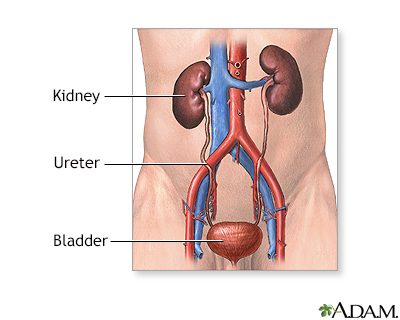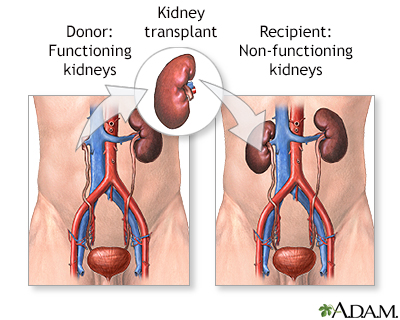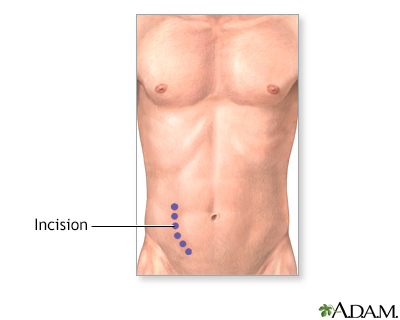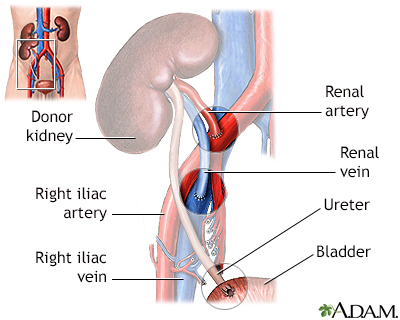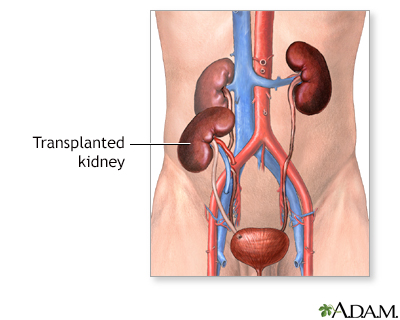Kidney transplant
Renal transplant; Transplant - kidneyA kidney transplant is surgery to place a healthy kidney into a person with kidney failure.
Kidney failure
Acute kidney failure is the rapid (less than 2 days) loss of your kidneys' ability to remove waste and help balance fluids and electrolytes in your b...

Description
Kidney transplants are one of the most common transplant operations in the United States.
One donated kidney is needed to replace the work previously done by your kidneys.
The donated kidney may be from a:
- Living related donor - related to the person receiving the transplant, such as a parent, sibling, or child
- Living unrelated donor - such as a friend or spouse
- Deceased donor - a person who has recently died and who has no known chronic kidney disease
The healthy kidney is transported in a special solution that preserves the organ for up to 48 hours. This gives the health care providers time to perform tests to ensure that the donor's and recipient's blood and tissue match.
PROCEDURE FOR A LIVING KIDNEY DONOR
If you are donating a kidney, you will be placed under general anesthesia before surgery. This means you will be asleep and pain-free. Surgeons today can often use small surgical cuts with laparoscopic techniques to remove the kidney.
PROCEDURE FOR THE PERSON RECEIVING THE KIDNEY (RECIPIENT)
People receiving a kidney transplant are given general anesthesia before surgery.
- The surgeon makes a cut in the lower belly area.
- Your surgeon places the new kidney inside your lower belly. The artery and vein of the new kidney are connected to the artery and vein in your pelvis. Your blood flows through the new kidney, which makes urine just like your own kidneys did when they were healthy. The tube that carries urine (ureter) is then attached to your bladder.
- Your own kidneys are left in place unless they are causing a medical problem. The wound is then closed.
Kidney transplant surgery takes about 3 hours. People with diabetes may also have a pancreas transplant done at the same time. This can add another 3 hours to the surgery.
Why the Procedure Is Performed
You may need a kidney transplant if you have end-stage kidney disease. The most common cause of end-stage kidney disease in the United States is diabetes. However, there are many other causes.
A kidney transplant may NOT be done if you have:
- Certain infections, such as TB or bone infections
- Problems taking medicines several times each day for the rest of your life
- Heart, lung, or liver disease
- Other life-threatening diseases
- Recent history of cancer
- Infections, such as hepatitis
- Current behaviors such as smoking, alcohol or drug abuse, or other risky lifestyle habits
Risks
Specific risks related to this procedure include:
- Blood clots (deep venous thrombosis)
- Heart attack or stroke
- Wound infections
- Side effects from medicines used to prevent transplant rejection
- Loss of transplanted kidney
Before the Procedure
You will be evaluated by a team at the transplant center. They will want to make sure that you are a good candidate for a kidney transplant. You will have several visits over a period of several weeks or months. You will need to have blood drawn and x-rays taken.
Tests done before the procedure include:
- Tissue and blood typing to help make sure your body will not reject the donated kidney
- Blood tests or skin tests to check for infections
- Heart tests such as an ECG, echocardiogram, or cardiac catheterization
- Tests to look for early cancer
You will also want to consider one or more transplant centers to determine which is best for you.
- Ask the center how many transplants they perform every year and what their survival rates are. Compare these numbers to those of other transplant centers.
- Ask about support groups they have available and what type of travel and housing arrangements they offer.
If the transplant team believes you are a good candidate for a kidney transplant, you will be put on a national waiting list.
Your place on a waiting list is based on a number of factors. Key factors include the type of kidney problems you have, how severe your kidney disease is, what other conditions you have, such as heart disease, and the likelihood that a transplant will be successful.
For adults, the amount of time you spend on a waiting list is not the most important or main factor in how soon you get a kidney. Most people waiting for a kidney transplant are on dialysis. While you are waiting for a kidney:
- Follow any diet your transplant team recommends.
- Do not drink alcohol.
- Do not smoke.
- Keep your weight in the range that has been recommended. Follow any recommended exercise program.
- Take all medicines as they have been prescribed for you. Report any changes in your medicines and any new or worsening medical problems to the transplant team.
- Go to all regular visits with your regular doctor and transplant team. Make sure the transplant team has the correct phone numbers so they can contact you right away if a kidney becomes available. Always make sure that you can be contacted quickly and easily.
- Have everything ready in advance to go to the hospital.
After the Procedure
If you have received a donated kidney, you will need to stay in the hospital for about 3 to 7 days. You will need close follow-up by your transplant team and regular blood tests for 1 to 2 months.
The recovery period is about 6 months. Often, your transplant team will ask you to stay close to the hospital for the first 3 months. You will need to have regular check-ups with blood tests and x-rays for many years.
Outlook (Prognosis)
Almost everyone feels that they have a better quality of life after the transplant. Those who receive a kidney from a living related donor do better than those who receive a kidney from a donor who has died. If you donate a kidney, you can most often live safely without complications with your one remaining kidney.
People who receive a transplanted kidney may reject the new organ. This means that their immune system sees the new kidney as a foreign substance and tries to destroy it.
In order to avoid rejection, almost all kidney transplant recipients must take medicines that suppress their immune response for the rest of their life. This is called immunosuppressive therapy. Although the treatment helps prevent organ rejection, it also puts patients at a higher risk for infection and cancer. If you take this type of medicine, you need to be screened for cancer. The medicines may also cause high blood pressure and high cholesterol and increase the risk for diabetes.
A successful kidney transplant requires close follow-up with your doctor and you must always take your medicine as directed.
References
Barlow AD, Nicholson ML. Kidney transplantation surgery. In: Johnson RJ, Floege J, Tonelli M, eds. Comprehensive Clinical Nephrology. 7th ed. Philadelphia, PA: Elsevier; 2024:chap 108.
Becker Y. Kidney and pancreas transplantation. In: Townsend CM Jr, Beauchamp RD, Evers BM, Mattox KL, eds. Sabiston Textbook of Surgery. 21st ed. St Louis, MO: Elsevier; 2022:chap 27.
-
Kidney anatomy - illustration
The kidneys are responsible for removing wastes from the body, regulating electrolyte balance and blood pressure, and the stimulation of red blood cell production.
Kidney anatomy
illustration
-
Kidney - blood and urine flow - illustration
This is the typical appearance of the blood vessels (vasculature) and urine flow pattern in the kidney. The blood vessels are shown in red and the urine flow pattern in yellow.
Kidney - blood and urine flow
illustration
-
Kidneys - illustration
The kidneys are located in the posterior abdomen and are responsible for filtering urine from the blood.
Kidneys
illustration
-
Kidney transplant - series
Presentation
-
Kidney anatomy - illustration
The kidneys are responsible for removing wastes from the body, regulating electrolyte balance and blood pressure, and the stimulation of red blood cell production.
Kidney anatomy
illustration
-
Kidney - blood and urine flow - illustration
This is the typical appearance of the blood vessels (vasculature) and urine flow pattern in the kidney. The blood vessels are shown in red and the urine flow pattern in yellow.
Kidney - blood and urine flow
illustration
-
Kidneys - illustration
The kidneys are located in the posterior abdomen and are responsible for filtering urine from the blood.
Kidneys
illustration
-
Kidney transplant - series
Presentation
Review Date: 4/1/2023
Reviewed By: Kelly L. Stratton, MD, FACS, Associate Professor, Department of Urology, University of Oklahoma Health Sciences Center, Oklahoma City, OK. Also reviewed by David C. Dugdale, MD, Medical Director, Brenda Conaway, Editorial Director, and the A.D.A.M. Editorial team.






